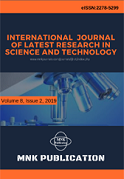DOI:10.29111/ijlrst ISRA Impact Factor:3.35, Peer-reviewed, Open-access Journal
Research Paper Open Access
International Journal of Latest Research in Science and Technology Vol.5 Issue 1, pp 134-141,Year 2016
Correspondence should be addressed to :
Received : 20 February 2016; Accepted : 25 February 2016 ; Published : 29 February 2016

| Download | 125 |
|---|---|
| View | 178 |
| Article No. | 10626 |
The Web 2.0 is enabled by the Internet technology. The implementation of Information and Communication Technology (ICT) accelarates the transformation of educational institutions and their methods of operations. The use of ICT at universities opens many possibilities for improving educational services for teachers as well as for students, but also increases their active participation in didactic processes. Students reveal opportunities for their involvement and they are looking for new sources of knowledge, particularly through involvement of other colleagues. The paper aims to understand challenges in developing the open education architecture that supports formal and informal learning at universities.
Copyright © 2016 Malgorzata Pankowska et al. This is an open access article distributed under the Creative Commons Attribution 4.0 International (CC BY 4.0) license which permits unrestricted use, distribution, and reproduction in any medium, provided the original work is properly cited.
Malgorzata Pankowska , " University 2.0 Architecture For Informal Learning ", International Journal of Latest Research in Science and Technology . Vol. 5, Issue 1, pp 134-141 , 2016

MNK Publication was founded in 2012 to upholder revolutionary ideas that would advance the research and practice of business and management. Today, we comply with to advance fresh thinking in latest scientific fields where we think we can make a real difference and growth now also including medical and social care, education,management and engineering.

We offers several opportunities for partnership and tie-up with individual, corporate and organizational level. We are working on the open access platform. Editors, authors, readers, librarians and conference organizer can work together. We are giving open opportunities to all. Our team is always willing to work and collaborate to promote open access publication.

Our Journals provide one of the strongest International open access platform for research communities. Our conference proceeding services provide conference organizers a privileged platform for publishing extended conference papers as journal publications. It is deliberated to disseminate scientific research and to establish long term International collaborations and partnerships with academic communities and conference organizers.